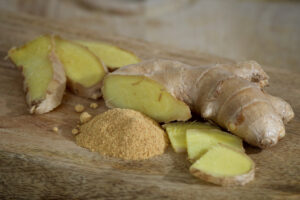Check this out!
 Where did the idea to dehydrate garden companion herbs start? It starts with your garden planning which includes natural pest control. Herbs make excellent companion plants throughout the garden because their aroma deters pests from invading your precious crops.
Where did the idea to dehydrate garden companion herbs start? It starts with your garden planning which includes natural pest control. Herbs make excellent companion plants throughout the garden because their aroma deters pests from invading your precious crops.
For instance, planting mint will repel mosquitoes and ants all the while attracting beneficial bees. Mint, although invasive, will protect garden crops susceptible to aphids. Planting dill and cilantro will discourage spider mites. Adding herbs in your vegetable garden provides fresh herbs to use when canning, cooking and also allows you to dehydrate them for long-term storage.
What is Dehydrating?
Dehydrating is essentially the drying of foods using air current and heat. Home dehydrating foods allows you to dry foods without additives found in many commercially dried goods. The key is removing enough moisture from the foods to prevent spoiling during storage. For this reason it is better to over dry versus under dry especially with foods containing more moisture.
Dehydrated Herb Recipes
Here are quick drying recipes so you may dehydrate garden companion herbs this growing season:
Gingerroot
Peel ginger and cut crosswise into thin slices no more than 1/8” thick using a paring knife or course peeler. Place on mesh drying tray. Dry at 130°F for 4 to 4 ½ hours. Store strips intact in a mason jar free from sunlight. Grind into a power or chop fine before use.
Chives
Remove any tough ends. Place on mesh drying tray. Dry at 130°F for 6 hours. Chives will be very brittle and should break easily when bent. Store in a mason jar free from direct sunlight. Crumble into recipes.
Mint
Remove leaves from stem. Small leaf clusters can be left intact. Place on mesh drying tray with the thickest part of the leaf facing the airflow. Dry at 110°F for upwards of 15 hours. During drying, bring bottom tray up to the top, rotating each tray so it can have an hour or two nearest the heat source and airflow. Store in a stainless steel, airtight container. Keep leaves whole during storage. Steep a dreamy cup of tea with mint leaves or crumble into recipes.
Bay Leaves
Remove leaves from stems and branches. Place on mesh drying tray with the thickest part of the leaf facing the airflow. Dry at 110°F for upwards of 8 hours. During drying, bring bottom tray up to the top, rotating each tray so it can have an hour or two nearest the heat source and airflow. Store whole leaves in a mason jar free from direct sunlight. Use whole leaves in soups and pickling recipes.
Basil
Remove leaves from stem. Small leaf clusters can be left intact. Place on mesh drying tray with the thickest part of the leaf facing the airflow. Dry at 110°F for upwards of 20 hours. During drying, bring bottom tray up to the top, rotating each tray so it can have an hour or two nearest the heat source and airflow. Store whole leaves in a mason jar free from direct sunlight. Use whole or crumble into recipes.
Parsley
Pinch leaf stems with tree segments off the sprigs. Remove any course stems. Place on a mesh drying tray. Dry at 110°F for 8 hours. Leaves should be brittle and stems should break when bent. Store leaf segments whole in a mason jar free from direct sunlight. Crumble or use whole in any recipe or as garnishment.
Cilantro
Remove leaves from stems. Place on a mesh drying tray. Dry at 110°F for 8 to 10 hours. Leaves should be brittle. Store leaves whole in a mason jar free from direct sunlight. Crumble into any recipe.
Sage
Remove leaves from stem. Small leaf clusters can be left intact. Place on mesh drying tray  with the thickest part of the leaf facing the airflow. Dry at 110°F for 14 hours. During drying, bring bottom tray up to the top, rotating each tray so it can have an hour or two nearest the heat source and airflow. Store whole leaves in a mason jar free from direct sunlight. Use whole or crumble into recipes.
with the thickest part of the leaf facing the airflow. Dry at 110°F for 14 hours. During drying, bring bottom tray up to the top, rotating each tray so it can have an hour or two nearest the heat source and airflow. Store whole leaves in a mason jar free from direct sunlight. Use whole or crumble into recipes.
Rosemary
Do not remove the leaves from the stems. Cut stems off prior to the thick, woody area. Place on mesh drying trays. Dry at 110°F for 12 to 14 hours. During drying, bring bottom tray up to the top, rotating each tray so it can have an hour or two nearest the heat source and airflow. Strip the leaves from the stem and store leaves in a mason jar free from direct sunlight. Use whole or chop fine before use.
Thyme
Do not remove the leaves from the stems. Cut stems off prior to the thick, woody area. Place on mesh drying trays. Dry at 110°F for 12 to 14 hours. During drying, bring bottom tray up to the top, rotating each tray so it can have an hour or two nearest the heat source and airflow. Strip the leaves from the stem and store leaves in a mason jar free from direct sunlight. Use whole or chop fine before use.
Happy Preserving~
Diane, The Canning Diva


